Blueprint
Available for a Successful Diabetes Self-Management
Education Program
A program study of the successful diabetes program at the Bay Clinic, Inc., in
now available. The
Development of a Diabetes Self-Management Education Program at the Bay Clinic,
Inc.: a Program Study was funded
by the Charitable Mentor Fund of Boston that intends to use the document as a
blueprint to assist other community health centers to start similar programs
in
other
multi-cultural
communities.
HIThe Bay Clinic, Inc.,
is a nonprofit, federally qualified community health
center on Hawai‘i Island. It is part of the national
health safety net for low income, uninsured and medically
under-served populations. Community health centers are
among the most cost-effective federal programs. They
effectively keep medical costs low while delivering excellent
evidence-based health care and meeting top national standards.
Bay Clinic’s groups are among the hardest hit by diabetes.
HIIn 2009,
the federal government ranked the Bay Clinic first among 44 rural facilities
nationwide for its service to people with diabetes. During fiscal year 2009,
the rural clinics joined a health care quality improvement initiative run by
the Health Resources and Services Administration’s Division of Rural Policy.
The Bay Clinic ranked first because its patients had the most improvement in
A1C blood glucose percentage from 8.1% to 7.8% across all patients for the year.
The normal range of the A1C is 4 to 6%. The A1C blood test gives a picture of
the glucose level in a person’s blood stream for the past few months.
A
series of classes, then long-term support groups
The focus of the Bay Clinic program has been the series of eleven weekly classes
it has offered people diagnosed with diabetes since 2004. The classes follow
guidelines developed by the American Diabetes Association. The classes are
followed by long-term support groups that meet weekly.HI
HI HI HI HI HI HI HI HI HI I HI HI HI HII HIA recent survey compared
13 people in the long-term support group from their start at the Bay Clinic
to their outcomes in October 2009. When the participants entered the program
their A1Cs averaged 8.11%; in 2009 the average was 6.42%. All 13 attended the
Diabetes Self-Management Education classes and continued as members of the
Warriors Against Diabetes long-term support group. Average time attending group
sessions is 30 months.
HIParticipants can
interact with providers after each session if
they wish, about any health problem. The program
is now available at all four of the Bay Clinic’s
Family Health Centers.

Charlotte
Grimm, an Advanced Practice Registered Nurse (APRN), and co-author
of the Program Study, is responding to questions posed by members
of a diabetes class. Grimm is the Director of Clinical Operations
of the nonprofit Bay Clinic, Inc. and helped create the diabetes
program. In front of her on the table are many healthy diabetes-friendly
foods created by class members that were brought for a potluck. Participants
in the classes have access to many different health care professionals
on a regular basis and after class may consult with them privately
if they care to. Stacy Haumea is shown on the right. She is also
a co-author of the report, is a Registered Dietitian, a Nutritionist, a Certified
Diabetes Educator and is the Director of Diabetes Education at the
Bay Clinic.
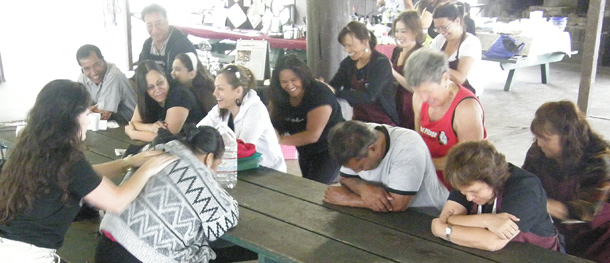 On
the First Wednesday of each month all the Bay
Clinic's diabetes classes meet at Wailoa River
State Park in Hilo from 9:30 to 11:30 a.m. The
public is invited. There is a speaker of general
interest, a lesson from the series of diabetes
classes offered by the Clinic, an exercise routine
led by community volunteer Hannah Hedrick (in
red) who is in the photograph leading the group
in what she calls jigga, jigga, a routine to
get people to vigorously rub each other's backs
and shoulders. Hannah is inspiring because, besides
her charming personality, she is 70 years old,
has had two hips and a femur replaced and suffers
from arthritis. Hedrick and the Bay Clinic Warriors
group are working to create an exercise video.
Hedrick and Tom Whitney are advocates of self-help
groups to deal with diabetes. Following the exercise
routines is a huge potluck in which usually about
forty people bring diabetes-friendly foods to
share.
On
the First Wednesday of each month all the Bay
Clinic's diabetes classes meet at Wailoa River
State Park in Hilo from 9:30 to 11:30 a.m. The
public is invited. There is a speaker of general
interest, a lesson from the series of diabetes
classes offered by the Clinic, an exercise routine
led by community volunteer Hannah Hedrick (in
red) who is in the photograph leading the group
in what she calls jigga, jigga, a routine to
get people to vigorously rub each other's backs
and shoulders. Hannah is inspiring because, besides
her charming personality, she is 70 years old,
has had two hips and a femur replaced and suffers
from arthritis. Hedrick and the Bay Clinic Warriors
group are working to create an exercise video.
Hedrick and Tom Whitney are advocates of self-help
groups to deal with diabetes. Following the exercise
routines is a huge potluck in which usually about
forty people bring diabetes-friendly foods to
share.
 HIBay
Clinic supplements very brief acute-care, one-on-one
doctor patient interactions with a team of health
care providers focused on empowering patients to
self-manage their treatment of their own diabetes.
This is a big shift in health care for chronic
illness. The term within the health care profession
for this is the Chronic Care Model. It requires
a re-thinking of roles by everyone in the health
care professions to now place the patient on an
equal level with the health care professionals
as an expert in managing their own care.
HIBay
Clinic supplements very brief acute-care, one-on-one
doctor patient interactions with a team of health
care providers focused on empowering patients to
self-manage their treatment of their own diabetes.
This is a big shift in health care for chronic
illness. The term within the health care profession
for this is the Chronic Care Model. It requires
a re-thinking of roles by everyone in the health
care professions to now place the patient on an
equal level with the health care professionals
as an expert in managing their own care.
HIOne of the support groups calls itself
the Warriors Against Diabetes which includes participant advocates who
reach out to involve the public in monthly meetings in a beautiful local
park with the theme: Living the Sweet Life Healthy – and having fun doing
it!
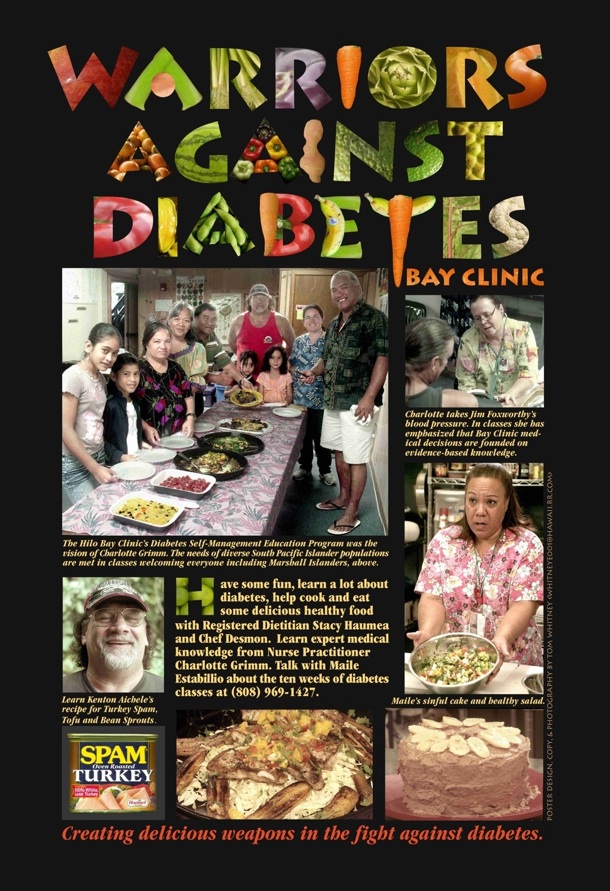 This
is a poster placed on the walls of the
five Bay Clinic waiting rooms. It gets
across the idea that food choices are
a very important part of the solution
to problems with diabetes and an important
part of the program.
This
is a poster placed on the walls of the
five Bay Clinic waiting rooms. It gets
across the idea that food choices are
a very important part of the solution
to problems with diabetes and an important
part of the program.
HIThe
program has been successful in engaging hard-to-reach
Pacific Islander populations. Classes are also offered
for people who speak the language of the Marshall
Islands and for those from the Island of Truk in
the South Pacific.
HIThe
Bay Clinic is operating the program effectively with non-physician health
care providers: Advance Practice Registered Nurses, Physician Assistants,
Registered Dietitians and Behavioral Health staff. A physician is available
for consulting.
Getting
a program started
To establish a self-supporting diabetes education program like the Bay Clinic’s,
(where staff time for the education will be paid for by health insurance companies
and Medicare) an entity must become certified by the American Diabetes Association
(ADA). When this is achieved, all health insurers are likely to allow billing
for diabetes education services. In Hawaii it was finally discovered that providers
do not have to be Certified Diabetes Educators (CDE). The Hawaii Medical Service
Organization position was that that staff did not have to be CDEs, but they had to be eligible to be CDEs. This new arrangement from HMSA gave the Bay
Clinic’s diabetes program the ability to bill for education by a Registered
Nurse, a Registered Dietitian, a Medical Doctor and an Advanced Practice Registered
Nurse, all professions that are eligible to become CDEs. Years later, at the time this report was written, Stacy Haumea, who
is the Director of Diabetes Education at the Bay Clinic and is a Registered Dietitian, has become a Certified Diabetic Educator. While the ADA
application process is underway, health providers are able to bill for
medical consultation services that are provided after the diabetes classes.
HIOne of the program’s goals was financial
sustainability through revenue collected for diabetes education services
rendered. The Clinic achieved this in 2009. Grant funding helped sustain
program costs until certification was received. This involved obtaining
grants and assistance from local health insurers, pharmaceutical companies,
foundations and food stores. Each step in the process is described in the
Program
Study.
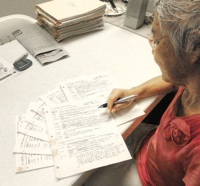
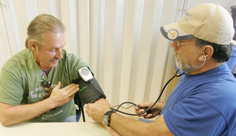 To to To understand their daily patterns of food, water and
exercise, many people find it helpful to keep a detailed
diary for a few weeks or longer as Pearl Kadota shows
us. As part of learning to take care of themselves
and their diabetes, in the middle photograph Kenton
Aichele is taking Jim Foxworthy's blood pressure
before the start of a support group meeting.
To to To understand their daily patterns of food, water and
exercise, many people find it helpful to keep a detailed
diary for a few weeks or longer as Pearl Kadota shows
us. As part of learning to take care of themselves
and their diabetes, in the middle photograph Kenton
Aichele is taking Jim Foxworthy's blood pressure
before the start of a support group meeting.
The
Complete Program Study is available only on Bay
Clinic Diabetes DVDs To
obtain the two Program Study DVDs as described
in this text, send $15 for the Diabetes
Program DVDs to the Bay Clinic, 224 Haili Street,
Suite B, Hilo, HI 96720, attention Monica Adams.
This will cover disc duplication, labeling, and postage. mi mi miAvailable here and on the DVDs from the Bay Clinic are the
Procedures and Forms the Bay Clinic has created
to implement the program. This section is a
detailed guide to create a program, along with
the Program Study. Other items available here are a Basic Diabetes Library list, and
Internet Resources for Diabetes. Included on the DVDs are a copy of the original Quality
Improvement Plan with a 2009 update showing
how the Clinic has implemented the Chronic
Care Model, copies of a diabetes program proposal
and final report to the funder, a Bay Clinic
Brochure, sections that include news and magazine articles
about the program, and all Bay Clinic PowerPoint presentations
about the program.
HIIn
addition, a section on graphics is available on the DVDs. One of the patients
created a vegetable alphabet that Bay Clinic is using to create
posters for the monthly meetings in the local park. It was also
used to create the Warriors Against Diabetes logo. Since food is
an important part of the solution to diabetes, other diabetes programs
may want to use the alphabet. The group has t shirts available
with the Warriors logo.
HIAlso
available on Diabetes DVD 2 from the Clinic is a session showing the
visit with the Warriors in 2008 by Dr. Richard Jackson of the Joslin
Diabetes Center in Boston and an interview by Charlotte Grimm of Dr.
Dijon Lim, a Hilo cardiologist talking about the relationship of heart
disease and diabetes. Diabetes DVD 1 contains the Program Study and the
items described above, for those who cannot download the information
over the Internet.
HICo-authors
of the study include Tom Whitney, a writer and diabetes patient at the
Bay Clinic; Charlotte Grimm, an Advanced Practice Registered Nurse who
helped start the program and is Director of Clinical Operations at the
Bay Clinic; Stacy Haumea, Nutritionist, Registered Dietitian and Certified
Diabetes Educator who is the Director of Diabetes Education
at the Clinic; and Monica Adams, a mental health counselor who is also
the Development Director at the Bay Clinic.
HIThose
with more
questions about the study can contact Monica Adams at (808) 961-4080
or by email at madams@bayclinic.org.
Short
Summary of Bay Clinic's Diabetes Self-Management
Education Program Highlights
1.
The Program Summary and the Bay Clinic Diabetes
DVD offer a blueprint of the diabetes program developed
at Bay Clinic, Inc., that could be applied in other
multi-cultural communities.
2.
Bay Clinic, Inc., is a nonprofit, Federally Qualified
Community Health Center on Hawaii‘i Island. Bay Clinic
is part of the national health safety net for low income,
uninsured and medically under-served populations.
3.
In 2009, the federal government ranked the Bay Clinic
first among 44 rural facilities nationwide, including
one run by the Mayo Clinic, for its service to people
with diabetes. During Fiscal Year 2009, the rural clinics
joined a health care quality improvement initiative
run by the Health Resources and Services Administration’s
Division of Rural Policy. The Bay Clinic ranked first
because its patients had the most improvement in HbA1C
blood glucose percentage from 8.1 to 7.8 across all
patients for the year.
4.
Community health centers are among the most cost-effective
federal programs. They are good at keeping medical
costs low while delivering excellent evidence-based
health care while meeting top national standards.
5.
Bay Clinic supplements brief acute-care, one-on-one
doctor patient interactions with a team of health care
providers focused on empowering patients to take control
of managing disease, especially chronic disease. This
is a big shift in health care for chronic illness.
6.
For diabetes, the Bay Clinic approach is to offer 11
weeks of classes followed by long-term weekly support
groups. Participants can interact with providers after
each session if they wish, about any health problem.
7.
One of the support groups is the Warriors Against Diabetes
that includes participant advocates who reach out to
involve the public in monthly meetings in a beautiful
local park with the theme: Living the Sweet Life Healthy
– and having fun doing it! The program has been successful
in engaging hard-to-reach Pacific Islander populations. The Warriors web page is here: http://www.tomwhitney.net/DiabetesAdvocacy.html
8.
The Bay Clinic is operating the program effectively
with non-physician health care providers: Advance Practice
Registered Nurses, Physician Assistants, Registered
Dietitians and Behavioral Health staff. A physician
is available for consulting.
9.
One of the program’s goals is financial sustainability
through revenue collected for education services rendered.
To achieve this, programs must become certified by
the American Diabetes Association. Grant funding helps
sustain program costs until certification is received.
Brief
Outline of Initial Steps to Implement a Program
Similar to the Bay Clinic Diabetes Program
To establish a self-supporting diabetes education program like the Bay Clinic’s,
an entity must become certified by the American Diabetes Association (ADA).
When this is achieved, all health insurers are likely to allow billing for
diabetes education services. While the ADA application process is underway,
health providers will be able to bill for medical consultation services that
are provided after the diabetes classes. Becoming certified requires applying
to the ADA and beginning to deliver a diabetes self-management program consistent
with the ADA policies. Local funding will be needed to support the education program,
a dietitian and the food purchases until it can exist entirely by billing for
services. This will involve obtaining grants and assistance from
local health insurers, pharmaceutical companies, foundations and food stores.
1.
Apply to the ADA. The website for complete information
for organizations seeking recognition by the American
Diabetes Association to operate Diabetes Self-Management
Education programs is:
http://professional.diabetes.org/Recognition.aspx?typ=15&cid=57996
2.
Item 2 on the Bay Clinic Diabetes DVD
and available above contains the Procedures and Forms the Bay Clinic has developed to implement the program. This is a detailed guide to create a program, along with the narrative tin the Program Study document.
3.
This new approach to chronic disease management is
different than typically brief acute-care sessions. It requires adjustment by all health care
providers to include the patient as the most important part of the health care
team. An excellent introduction to this is provided in the book The Art of
Empowerment, by Bob Anderson, EdD, and Martha Funnell, MS, RN, CDE. Equally
important is becoming familiar with the Chronic Care Model. Try here: http://www.ihi.org/IHI/Topics/ChronicConditions/Diabetes/HowToImprove/
4.
Use grant-writing resources for fund development. There
are many useful papers published by the Grantsmanship
Center in Los Angeles, important for both fund raising
and obtaining grants from foundations and the federal
government. The Center also offers highly regarded
training in
cities around the country. Many funding sources have
adopted and approve of the Center’s methods. Visit
the Center’s website: http://www.tgci.com/about.shtml.
For their publications go here: https://www.tgci.com/publications.php.
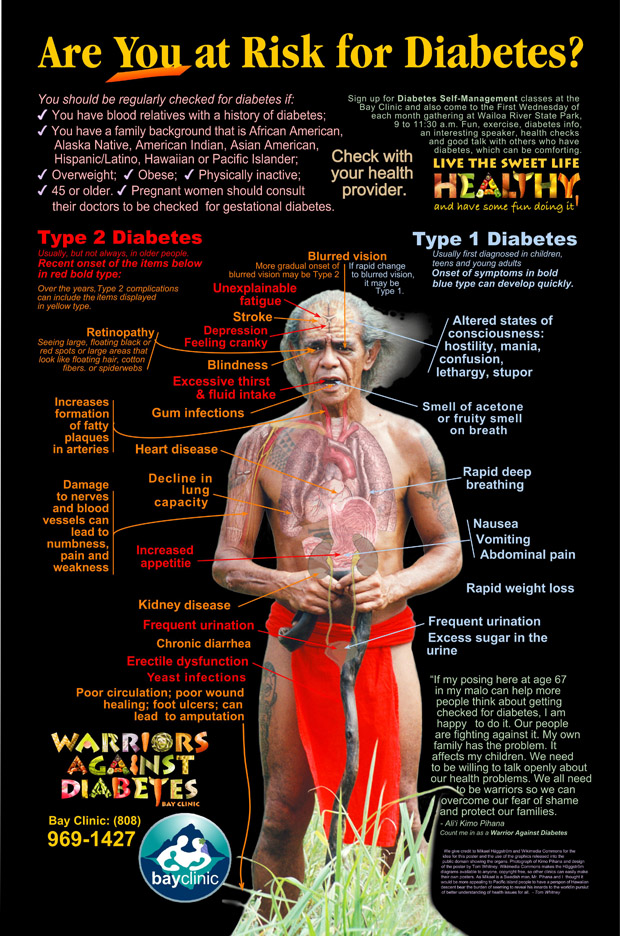 This poster was created using graphics
available in the public domain at WikiMedia Commons.
In Google, search using these words: Human Body
Diagrams - Wikimedia Commons Anyone is welcome
to use our words here and insert a photograph of someone
who is member of their community. We heartily give credit to Norwegian medical student Mikael Haggstrom for creating the project. At Haggstrom Diagrams you can see more examples of medical diagrams freely available for use by anyone.
This poster was created using graphics
available in the public domain at WikiMedia Commons.
In Google, search using these words: Human Body
Diagrams - Wikimedia Commons Anyone is welcome
to use our words here and insert a photograph of someone
who is member of their community. We heartily give credit to Norwegian medical student Mikael Haggstrom for creating the project. At Haggstrom Diagrams you can see more examples of medical diagrams freely available for use by anyone.
Ali‘i Kimo Pihana is the person in this photograph by Tom Whitney. Mr. Pihana made this statement included on the photograph: "If my posing here at age 67 in my malo can help more people think about getting checked for diabetes, I am all for it. Our people are fighting against it. My own family has the problem. It affects my children. We need to be willing to talk openly about our health problems. We all need to be warriors so we can overxcome our fear of shame and protect our families. Count me in as a Warrior Against Diabetes."

